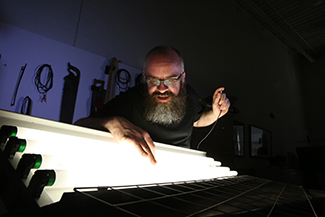"It's Alive"
Bringing film, fun, and Frankenstein, a Wabash art professor electrified small-town audiences across Indiana.
 I love the idea of the medicine show, journeying around the countryside selling ointments and tonics to skeptical but curious crowds. Using tantalizing tales of miracles and far-off places, the medicine man would demonstrate the powers of his elixirs through stunts and experiments.
I love the idea of the medicine show, journeying around the countryside selling ointments and tonics to skeptical but curious crowds. Using tantalizing tales of miracles and far-off places, the medicine man would demonstrate the powers of his elixirs through stunts and experiments.
My experience traveling throughout the state for Indiana Humanities was a close facsimile to this forgotten mischief of the charlatan. While I’m not hustling anyone’s money, I do try to tap into subconscious desires and, above all, I was there to perform a show.
I became a speaker for the organization’s One Story/One State Frankenstein project to engage two of my personal interests: film history and electricity.
I have a degree from the University of Colorado in film history and I am always looking for places to put that to use. The history of Frankenstein in film is long and fascinating, and it’s also, in Thomas Edison’s 1910 version, the world’s first scary movie. With well over 200 Frankenstein films developed throughout the world, I had plenty of material from which to choose.
At the same time, much of my work as a visual artist is inspired by electricity, specifically the relationship between its magical properties as a natural force and its taming into a consumable product. I could not resist the link between electricity’s life-giving connection to Frankenstein’s monster and Edison’s use of electricity to animate the dead, fixed image and illuminate it for the world to see.
What I had not been planning on talking about was Mary Shelley’s book itself, as I am not a literary scholar. However, I became obsessed with trying to fathom how an 18-year-old woman was able to conjure a phantasm so powerful that it would only grow in importance 200 years later. How would someone find that inspiration and harness their creativity to produce such a skillful work that seems impossibly prophetic?
So I assembled my stories, facts, and photographs and headed off to share my new obsession: How is inspiration created? As in any good medicine show, I knew that my talks had to provide visceral experiences. If I learned anything from Shelley it was that such moments are at the heart of inspiration.
I bookended my shows with two demonstrations of electricity as magic. Using a 9-volt battery applied to the hand muscles of an audience member, I began each show by usurping their muscle control by overriding the .07 volts we use to move our body, and taking control of the movements of the thumb. This moment was echoed later as we watched a clip of James Whale’s 1931 film Frankenstein, in which the first sign of life is a twitch of the thumb. I ended the show with a brief performance of a fluorescent tube musical instrument that elicits the eerie, electric sounds of Frankenstein and Nikola Tesla.
with each and every small-town visit, my reverie of the traveling medicine show grew. As I unpacked my equipment in libraries across Indiana and met families and community members, I enjoyed thoughtful conversations with strangers about the nature of creativity, electricity and wonder.
I met a young boy east of Indianapolis who was eager to see what electric sounds he could create with his guitar amp and his home appliances if his parents would let him. I had a wonderful conversation with a woman in LaPorte about racism and science history. I ate an amazing cheeseburger in Greenfield after a long conversation about how children process fear differently than adults. A man in Martinsville brought us a signed original movie poster from Frankenstein to look at. A thought-provoking discussion about Shelley’s novel broke out at the Irvington Historical Society, while a wonderful woman in Monticello told me that her experience of the show was like magic.
I was the main benefactor of these visits to wonderful communities across Indiana, where I shared my obsessions with attentive crowds of fascinating people. All these face-to-face encounters did feel like magic at a time when we increasingly interact online and look into our phones more often than into the eyes of our neighbors. If not the antidote, they are at least tonic for what ails us.
MATTHEW WEEDMAN is BKT Assistant Professor of Art at Wabash, and was a member of the Speaker’s Bureau for Indiana Humanities 2018 One Story/One State project: Frankenstein.